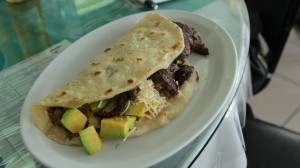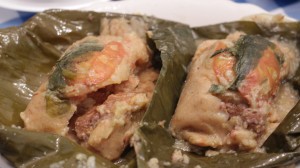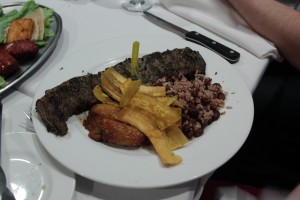Posted April 28, 2013
By NANCY CERMENO
For some Central American residents of Miami, food is a bridge to the culture of the country they left behind.
Central American cuisine has its roots in the subsistent agriculture of pre-Colombian Mesoamerican societies and further developed with Spanish colonization. The most common and abundantly consumed of those foods included corn, red beans, tomatoes, yucca (cassava) and squash.
With the expansion of animal husbandry by Spanish colonizers, each country developed its own way of preparing the same ingredients without letting go of their indigenous influence.
Central American countries share a foundation of indigenous, European and African influences. All these restaurants use corn, beans, fresh cheese/cream, tropical fruits, tomatoes, yucca and meat, but it is the combination and preparation of these ingredients that defines their signature dishes.
Three Miami-area restaurants provide sought out signature dishes to discerning diners. Caribe #2, El Atlakat and El Novillo attract their customers with traditional recipes and hospitality. These restaurants are ambassadors of Central American cuisine that offer quality, freshness and excellent service at reasonable prices.
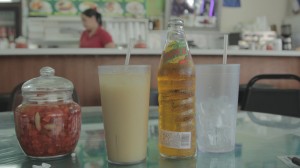
To the left is the nance drink made from a Central American fruit of the same name and to the right is the Banana soda from Honduras served at Caribe #2 in Little Havana.
Caribe #2, located in Little Havana, is an example of the kind of culture mix that has made Miami famous. Caribe serves Honduran food and is owned by an Ecuadorian couple, Fanny Mejia and her husband Jose Matute, who bought the restaurant 17 years ago.
It is a casual cafeteria/diner with a jukebox filled with Latin American song selections.
A traditional dish in Caribe’s menu is the sopa de caracol ($10), or conch chowder, which shares its name with a famous Honduran song. The soup is made with coconut milk, shredded coconut, conch, shrimp, tilapia, yucca, green plantains, and carrots, accompanied with rice, and a house-made corn tortilla.
The soup is offered during the weekends only and takes around four hours to prepare. On Sundays, the restaurant is packed with patrons and, on occasion, a line forms outside with people waiting for a seat and a bowl of sopa de caracol. The soup, which is served beginning at 11 a.m., is sometimes gone as early as 1 p.m. The hearty and rich chowder is well worth the wait.
In Honduran cuisine coconuts are more widely used than in other Central American countries. Honduras’ long Atlantic coast has shaped its culture and cuisine to reflect a strong Caribbean influence with its many fish dishes. Jamaica and the Bahamas have their own version of conch chowder, similar to the Honduran dish.
The most-popular dish from the restaurant is the baleada ($2), a freshly prepared thick flour tortilla, filled with fried beans, hard white cheese and sour cream.
Baleadas also come with avocado or scrambled eggs ($2.50), sausage or grilled steak ($3.50), or a combination of all those ingredients ($5).
If you are really hungry, ask for the baleada con todo, which is the baleada with everything (scrambled eggs, steak, beans, cheese, crema, avocado). The somewhat bland flavors of the tortilla and avocado go well with the saltiness of the finely shredded cheese and the savory flat iron flap meat
Chefs prepare the flour tortilla dough at the restaurant every day, sometimes more than once a day. Caribe #2 offers freshly prepared food when you order it, with the exception of frozen French fries and frozen uncooked yucca.
You will likely get a Spanish menu, but there is an English version available upon request.
The drink selection offers domestic and imported beers and sodas including Honduran Salvavidas beer, Banana and Uva sodas.
Diners at Caribe #2 expect hand made food, similar to what they would have at home. Countries like Honduras, El Salvador and Nicaragua do not have an abundance of processed food. In general, Central American cuisine is made entirely from scratch, frozen food is avoided and canned beans are completely unacceptable.
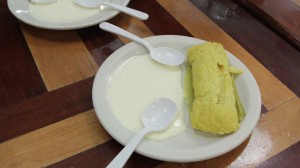
The tamal de elote at El Atlakat in Kendall is served with Central American crema (a richer sour cream).
El Atlakat opened in January 2005 and is located in a typical Kendall strip mall with more than ordinary restaurants (but that’s another story).
Walking into El Atlakat feels like being invited to a new friend’s house for dinner. The décor consists mostly of handcrafted souvenirs from El Salvador and landscape photos of the country.
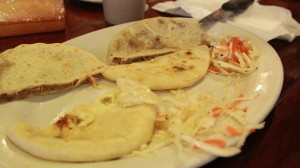
Two types of pupusas from El Atlakat, one with beans cheese and pork belly and the other with cheese and lorroco, served with pickled cabbage and and carrot salad.
Pupusas are a must, for they are a unique and savory staple of Salvadorian cuisine. Pupusas are made with corn tortillas. A popular filling comes with your choice of cheese and loroco — a green flower bud native to Central America that tastes like a mix between spinach and asparagus. They also come with refried beans, cheese and chicken ($2.75) or refried bean, cheese and pork belly ($2.75). Pupusas are also popular in Honduras although they did originate in El Salvador.
Another must is Salvadorian horchata ($2.25), a morro seed-based drink in water with vanilla essence, sesame seed, cocoa seed powder, cinnamon and nutmeg. It is a refreshing dessert drink, although you can buy horchata drink mix (just add milk or water) in some Miami grocery stores. El Atlakat makes its mix by hand. The restaurant sells the mix for $10 and it makes about five gallons.
Horchata was brought over by Spanish colonizers and varies in taste across Latin America. Although the drinks share the same name, the ingredients vary from country to country, some having a rice base while others use different seeds as a base.
Everything at El Atlakat is made from scratch, even the cuajada, a fresh mild soft cheese. Every Tuesday, they spend the entire day making tamal de elote. This tamale is made from ground young corn, which is sweeter because of its higher starch content, and served with crema, a Central American sour cream. They come wrapped in a cornhusk and are kept warm in a big pot over low heat.
The tamal, a corn meal based dish, dates back to the Aztec and Nahuatl people and is still popular today. Each country in Central America prepares the tamal differently making it their own. Nicaragua and Honduras share the nacatamal, which has the corn meal base but adds potato, pork, tomatoes and rice wrapped in plantain leaves.
El Atlakat has mostly Nicaraguan and Honduran regulars, but walk-ins are as multicultural as the city. From Haitians to Asians, to the French weekenders who come back for the good prices and the Salvadorian beer they have learned to love.
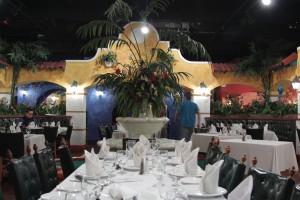
The working fountain and decor of El Novillo at Bird Ludlam Plaza adds to its authentic Nicaraguan ambiance.
El Novillo Restaurant & Lounge, a Nicaraguan steakhouse, opened in Westchester in 1989. Inside, the restaurant looks like a Nicaraguan country town, with replicas of colorful balconies sheltering the tables against the walls.
In the middle of the restaurant, there is a big stone fountain, simulating a Nicaraguan central plaza with tables surrounding it.
El Novillo prides itself on its tradition of Nicaraguan hospitality. It has an at home atmosphere with the kind of service and silverware you expect from fine dining establishments. It is place where you can be treated like a guest of honor while feeling as comfortable as you do among close friends.
El Novillo uses the lean tenderloin meat butterfly-cut into a steak. They also marinate the steak in chimichurri sauce — made with, parsley, garlic, olive oil, salt, pepper, vinegar, and sweet red peppers — for three to five minutes before it is grilled.
The house special steak is the churrasco, a beef butterflied tenderloin. You can order the classic El Novillo, which is 12 ounces ($21.99), the medium “Baby,” eight ounces ($17.99), or the extra large “Bid Daddy,” 16 ounces ($26.99). The steaks are made to order and are very juicy thanks to the chef’s special technique.
Churrasco is a Portuguese and Spanish term that refers to grilled meat. It is popular throughout Latin America although different countries use different cuts of beef sliced into a thin steak.
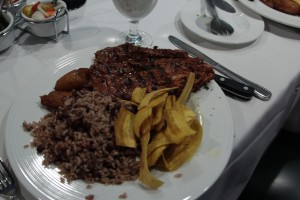
Achiote lean pork tenderloin from El Novillo served with gallo pinto, sweet plantains, and fried green plantain chips.
If you are in the mood for some of the best pork dishes from Nicaragua, try the achiote pork tenderloin ($16.99), a butterflied lean pork tenderloin, marinated in sour orange, lime juice, spices, and achiote or annatto, a seed used by Central Americans to give color that makes the pork look somewhat orange.
Annatto is used in all of Nicaragua’s pork dishes because Nicaraguans believe the natural color of pork makes the meal look dull. Nicaraguan cuisine tends to mix many tastes together and this dish is a perfect example as it pairs well with its sides to blend sweet, salty, sour, and savory together.
All the entrées are accompanied with gallo pinto (rice mixed with small red beans), sweet plantains and fried plantain chips which add sweetness and crispiness to the meals. The sides are brought to the table on a silver tray by the waiters and skillfully served to the amount you choose. Every table has extra chimichurri and a pickled carrot jalapeño and onion chilli for those who want to customize their dish.
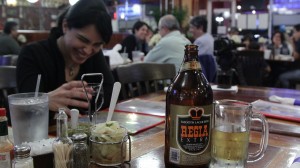
Regia beer, from El Salvador is served at El Atlakat in a 32-ounce bottle with a couple of beer mugs for sharing.
El Novillo offers a full-bar service, which includes 18-year-old rum Flor de Caña from Nicaragua, and a selection of domestic and imported beers.
These three restaurants offer authentic examples of the traditional cuisines from the countries that make Miami’s unique culture. Visiting them allows you an insider’s view of other countries’ food and amiability of their people.
Caribe #2
- Address: 1400 W. Flagler St., Miami, Fla. 33135
- Phone: 305-643-2772
- Prices: $$$$
- Hours: Mondays-Sundays 9 a.m.–10 p.m.
El Atlakat
- Address: 10855 SW 72nd St., #28, Miami, Fla. 33173
- Phone: 305-271-3101
- Prices: $$$$
- Hours: Mondays-Sundays 9 a.m.–11 p.m.
El Novillo
- Address: 6830 Bird Road, Miami, Fla. 33155
- Phone: 305-284-8417
- Prices: $$$$
- Hours: Mondays-Thursdays 12-10 p.m., Fridays 12–11 p.m., Saturdays 12–11 p.m., Sundays 12–10 p.m.

